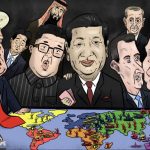Give Ukraine the jets it needs to win

US President Joe Biden’s decision on 19 May to help facilitate Ukraine’s efforts to procure advanced fourth-generation fighter aircraft was a significant shift in America’s posture. Announced at the G7 summit in Tokyo, the US reversal demonstrated that Biden had overcome his reticence to make such a move, which he had said could send escalatory signals to the Kremlin.
Kyiv has sought this outcome for a while, but until recently it had been met with Western vacillation. This time, like in the earlier impasse about heavy armour—broken when the UK announced it would send Challenger 2 tanks to Ukraine—the British government was again the first mover, promising to begin training Ukrainian pilots to fly a variety of Western military aircraft.
But why does Kyiv want Western warplanes so badly? Can it realistically put them to use in the foreseeable future? And which of its friends and partners might be able help?
To begin with, the Ukrainian air force has been seriously degraded by the Russian invasion. Frankly, it’s surprising that it continues to exist at all. One of the more egregious of Russia’s many strategic blunders, stemming from complacent expectations of a swift victory in 2022, was its failure to destroy Ukrainian airpower in the early days of the war. In the face of a robust Ukrainian air-defence network, heavily augmented by NATO military assistance, Russia is still unable to claim air supremacy.
That said, the Ukrainian air force is heavily constrained in its ability to operate effectively. Russia’s military can detect Ukrainian aircraft almost at will. Its own planes can fire standoff air-to-air missiles at Ukrainian aircraft at a greater range than Ukrainian warplanes possess. Ukraine’s main combat aircraft are Russian: the Su-27, which isn’t operated by any Western military, the multirole Mig-29 and the Su-25. And while Poland and Slovakia have recently donated replacement Mig-29s, access to spare parts remains a logistical headache.
The addition of Western combat aircraft will go a long way towards levelling the playing field in the air war. It will enable Ukraine’s air force to target Russian warplanes that currently operate with virtual impunity, often loitering just over the Russian border.
The ability to provide better air support for ground forces is another important reason Kyiv is so keen to acquire advanced Western airframes. While delivery lead times mean Ukraine is unlikely to acquire the planes in sufficient numbers in advance of its looming counteroffensive, they will be critical to defending any territory it recaptures. They will also help Ukraine protect its population and critical infrastructure against missiles and drones, which will doubtless form part of Russia’s response to any Ukrainian successes on the ground.
Critics have claimed that training the Ukrainian military to fly Western aircraft—something its pilots have no experience with—will take too long, and require more planes than Ukraine has pilots available. But those concerns are overblown. An experienced pilot can learn how to fly a Western aircraft like an F-16 Viper in a few weeks, and they can become fully trained in around six months. Ukraine has nearly 50 pilots it can spare, as well as engineering and support crews. And, according to the Ukrainian air force’s Yuri Ignat, around 24 warplanes would be sufficient to turn the tide.
That means Ukraine could be operating at least two squadrons of Western fighters before 2024—and at a time when weather conditions will make any Russian attempts to contest Ukrainian territorial gains more difficult.
The Ukrainian government has focused particularly on obtaining the venerable General Dynamics F-16. There are two reasons for that: a number of NATO countries operate them, and there are some 3,000 F-16s in service globally. The trouble is that many US allies are reluctant to release them to Ukraine, either because doing so would degrade their own ongoing operational needs, or because their F-16s are needed to backfill combat capabilities during the transition to more modern aircraft.
The Belgian government has announced that it can train pilots but can’t supply F-16s. Norway has already retired its F-16s, transferring 32 of them to Romania. Poland has said that donating some of its planes would weaken its combat power. Other NATO members like Greece and Turkey that operate the aircraft are clearly not minded to entertain giving them to Ukraine.
The most likely solution seems to be a coalition involving the Netherlands and Denmark. Dutch Prime Minister Mark Rutte said during a meeting with the UK’s Rishi Sunak that the topic was not taboo, and Denmark’s acting defence minister, Troels Lund Poulsen, claimed that he was ‘open to the idea’. It’s also conceivable—though unlikely—that spare planes might come from America’s aircraft boneyard adjoining Davis–Monthan airbase in Arizona. That would present Ukraine with the logistical problem of having to operate a cornucopia of different types of F-16s, which would also be delayed by the need to check and upgrade aircraft mothballed many years ago.
Perhaps Australia could help here. With its acquisition of the F-35A Lightning II well advanced, the air force still has around 40 F-18 ‘Classic’ Hornets in storage that it has so far failed to sell. The F-18 is not dissimilar to the F-16 in terms of its overall capabilities and would take roughly the same amount of time to train on. And while one report claims that Australia’s Hornets are outdated and degraded, others say they are in good condition and come with spare parts.
Moreover, despite strong initial contributions by both the current Australian government and its predecessor, concerns have recently been raised that Australia’s commitment to assist Kyiv shows signs of tapering off.
Under those circumstances, sending F-18s to Ukraine—or at least seriously investigating the prospect of doing so—would significantly bolster Australian support at a crucial time in Ukraine’s struggle to roll back Russia’s unprovoked, illegal and barbaric invasion.
This article was published by The Strategist.
Associate Professor Matthew Sussex is the Academic Director at the National Security College. His main research area is Russian foreign and security policy, but his interests also cover government and politics in Eurasia; strategic studies; terrorism and counter-terrorism; energy security; and Australian foreign policy.













